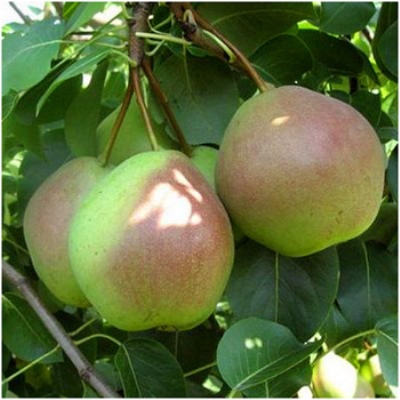
- Authors: Rossoshan Experimental Gardening Station
- Fruit weight, g: 250-350
- Ripening terms: late autumn
- Fruit picking time: from mid to late September
- Appointment: cooking compotes, making jam
- Growth type: medium height
- Yield: good
- Height, m: 5 to 7
- Crown: medium density, round-oval
- Leaves: large and medium, elliptical, green, short-pointed; the edge of the leaf is finely toothed; the plate is smooth, wavy, curved downward, no pubescence
The pear variety Rossoshanskaya late, dating back more than one decade, is so attractive for its qualities that it is very popular among private gardeners, farmers and consumers. Dessert fruits have not only increased sweetness, but also an excellent balance of chemical composition. The use of Rossoshanskaya fruits is universal - fresh consumption, making jams, jams, compotes.
Breeding history
The authors of the variety were employees of the Rossoshansk Horticultural Experimental Station, located near Voronezh. Pear Rossoshanskaya appeared as a result of crossing the famous Bere winter Michurinskaya and Forest beauty. After 16 years of variety testing, the pear was registered in the State Register of the Russian Federation.
Description of the variety
A powerful tree, the average height varies from 5 to 7 meters, has a round-oval crown of medium density, covered with dark green elliptical leaves. The smooth leaf plate is bent downward, has a short-pointed end, and its borders are dotted with small denticles. The entire vegetative mass is adapted to receive the maximum possible amount of light, since each leaf is attached to the shoots at an angle of 135 degrees.
Pros:
early maturity;
unpretentiousness;
high productivity;
excellent taste;
excellent keeping quality, transportability, presentation;
strong immunity and high resistance to pest attacks.
Of the minuses, one can note the need for crown formation, a decrease in frost resistance as we approach the northern regions, as well as the inability to self-pollinate.
Fruit characteristics
Large rounded fruits weighing 250-350 g are yellowish-green at the time of ripening. At the stage of consumer maturity, fruits acquire decorative appeal, becoming rich yellow, with a one-sided carmine blush.
Taste qualities
The juicy pulp of creamy shades has a sweet dessert taste with the addition of piquant sourness and is covered with a thin skin. The fragrant fruits can be stored until mid-winter (January-February) under appropriate conditions.
Ripening and fruiting
The variety belongs to the late autumn harvesting category (mid to late September), and the early fruiting category (4-5 years from the time of planting). The frequency of fruiting is irregular.

Yield
The pear has a good yield - up to 50 kilograms per tree, and from 120 to 300 kg / ha.
Growing regions
The variety was created for cultivation in the North Caucasus and in the Central Black Earth Region.
Self-fertility and the need for pollinators
The pear belongs to a partially self-fertile species, however, without proximity to varieties suitable for pollination (with similar flowering periods), one can not hope for a good harvest.These include - Rogneda and Mramornaya, Osennyaya Yakovleva and Tatiana, Severyanka and Chizhovskaya, Otradnenskaya and others.
Landing
Rossoshskaya late is planted in sunny areas, well sheltered from cold drafts. Planting is best done in the spring, when there is a long period of adaptation ahead. In those regions for which the variety is adapted, the autumn period does not threaten the health of the tree in any way, since the winters there are warm and mild.
A planting pit (80x80x100 cm) is prepared in about two weeks so that the earth has time to compact. At the bottom, a drainage layer of 15-20 cm is arranged from pebbles, crushed stone, broken brick. The excavated soil is enriched with organic matter, complex fertilizers, and wood ash. When preparing the pit, you should immediately install the support. It should be remembered that a pear does not tolerate close proximity to groundwater. When planting, the roots are spread over the surface of the earth and covered so that the root collar remains on the surface. The near-trunk circle is compacted, an earthen rampart is organized around it to retain water, it is watered abundantly, and the next day it is mulched with peat.


Growing and care
Subsequent care consists in standard procedures - regular watering, the introduction of nutrients and preventive treatments for diseases and pests, the organization of the seedling insulation for the winter, this procedure is not required for adult trees. Sanitary pruning involves removing old and damaged branches. Over time, the formation of the crown will be required, in order to avoid thickening, for about the third year. At this time, some of the skeletal and semi-skeletal branches are removed, the shoots of the current year are subjected to selective pinching so that the distance between tops is 10-20 cm.



Disease and pest resistance
The pear is highly resistant to scab and septoria, however, in autumn and spring, it should be sanitized with Bordeaux liquid, which gives an additional guarantee against fungal diseases and scab.

Like any other fruit trees, the pear needs protection from various diseases and pests.When planting a pear on your site, you need to know in advance what diseases you should beware of. To successfully carry out the struggle, it is necessary first to correctly identify the cause of the problem. It is important to distinguish signs of disease from manifestations of the presence of insects, mites, caterpillars and other types of pests.
Resistance to soil and climatic conditions
The variety has good winter hardiness, but this indicator decreases closer to the northern regions.





































































